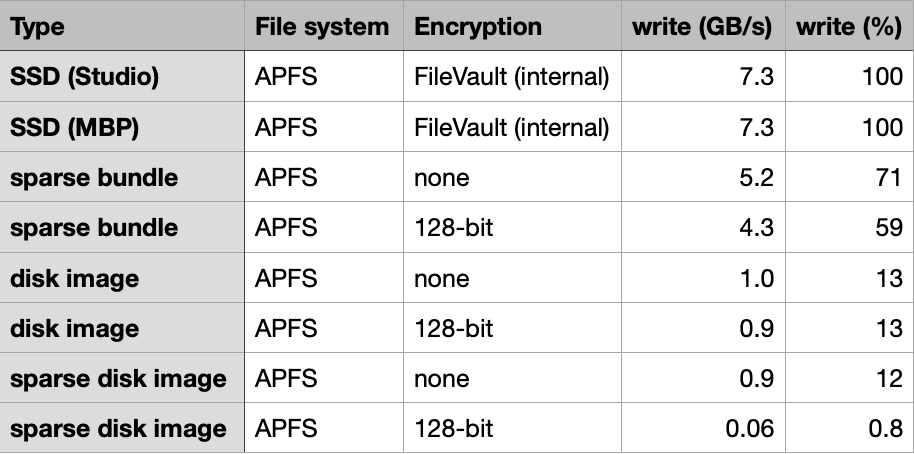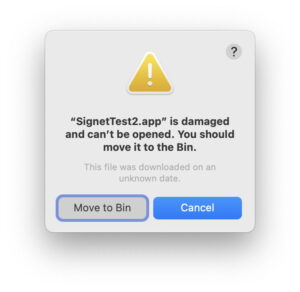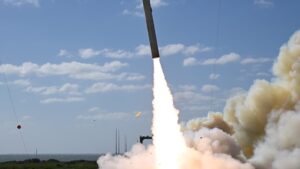Disk Images: Performance

Over the last few years, the performance of disk images has been keenly debated. In some cases, writing to a disk image proceeds at a snail’s pace, but this has appeared unpredictable. Over two years ago, I reported sometimes dismal write performance to disk images, summarised in the table below.
This article presents new results from tests performed using macOS 15.0.1 Sequoia, which should give a clearer picture of what performance to expect now.
Methods
Previous work highlighted discrepancies depending on how tests were performed, whether on freshly made disk images, or on those that had already been mounted and written to. The following protocol was used throughout these new tests:
A 100 GB APFS disk image was created using Disk Utility, which automatically mounts the disk image on completion.
A single folder was created on the mounted disk image, then it was unmounted.
After a few seconds, the disk image was mounted again by double-clicking it in the Finder, and was left mounted for at least 10 seconds before performing any tests. That should ensure read-write disk images are converted into sparse file format, and allows time for Trimming.
My utility Stibium then wrote 160 test files ranging in size from 2 MB to 2 GB in randomised order, a total of just over 53 GB, to the test folder.
Stibium then read those files back, in the same randomised order.
The disk image was then unmounted, its size checked, and it was trashed.
All tests were performed on a Mac Studio M1 Max, using its 2 TB internal SSD, and an external Samsung 980 Pro 2 TB SSD in an OWC Express 1M2 enclosure running in USB4 mode.
Results
These are summarised in the table below.
Read speeds for sparse bundles and read-write disk images were high, whether the container was encrypted or not. On the internal SSD, encryption resulted in read speeds about 1 GB/s lower than those for unencrypted tests, but differences for the external SSD were small and not consistent.
Write speeds were only high for sparse bundles, where they showed similar effects with encryption. Read-write disk images showed write speeds consistently about 1 GB/s, whether on the internal or external SSD, and regardless of encryption.
When unencrypted, read and write speeds for sparse (disk) images were also slower. Although faster than read-write disk images when writing to the internal SSD, read speed was around 2.2 GB/s for both. Results for encrypted sparse images were by far the worst of all the tests performed, and ranged between 0.08 to 0.5 GB/s.
Surprisingly good results were obtained from a new-style virtual machine with FileVault enabled in its disk image. Although previous tests had found read and write speeds of 4.4 and 0.7 GB/s respectively, the Sequoia VM achieved 5.9 and 4.5 GB/s.
Which disk image?
On grounds of performance only, the fastest and most consistent type of disk image is a sparse bundle (UDSB). Although on fast internal SSDs there is a reduction in read and write speeds of about 1 GB/s when encrypted using 256-bit AES, no such reduction should be seen on fast external SSDs.
On read speed alone, a read-write disk image is slightly faster than a sparse bundle, but its write speed is limited to 1 GB/s. For disk images that are more frequently read from than written to, read-write disk images should be almost as performant as sparse bundles.
However, sparse (disk) images delivered weakest performance, being particularly slow when encrypted. Compared with previous results from 2022, unencrypted write performance has improved, from 0.9 to 2.0 GB/s, but their use still can’t be recommended.
Performance range
It’s hard to explain how three different types of disk image can differ so widely in their performance. Using the same container encryption, write speeds ranged from 0.08 to 3.2 GB/s, for a sparse image and sparse bundle, on an external SSD with a native write speed of 3.2 GB/s. It’s almost as if sparse images are being deprecated by neglect.
Currently, excellent performance is also delivered by FileVault images used by Apple’s lightweight virtualisation on Apple silicon. The contrast is great between its 4.5 GB/s write speed and that of an encrypted sparse image at 0.1 GB/s, a factor of 45 when running on identical hardware.
Recommendations
For general use, sparse bundles (UDSB) are to be preferred for their consistently good read and write performance, whether encrypted or unencrypted.
When good write speed is less important, read-write disk images (UDRW) can be used, although their write performance is comparable to that of USB 3.2 Gen 2 at 10 Mb/s and no faster.
Sparse (disk) images (UDSP) are to be avoided, particularly when encrypted, as they’re likely to give disappointing performance.
Encrypting UDSB or UDRW disk images adds little if any performance overhead, and should be used whenever needed.
Previous articles
Introduction
Tools
How read-write disk images have gone sparse



